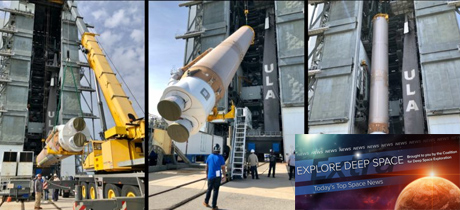In Today’s Deep Space Extra… Yesterday’s spacewalk equipped the International Space Station with its first Roll Out Solar Array. United Launch Alliance, Boeing continue preparations for Starliner’s OFT-2.
Human Space Exploration
ESA/NASA complete ISS spacewalk to install first new solar array
Coalition Member in the News – Boeing
NASAspaceflight.com (6/20): Spacewalking astronauts Thomas Pesquet, of the European Space Agency (ESA), and Shane Kimbrough, of NASA, completed the installation of the first Roll Out Solar Array (iROSA) outside the International Space Station (ISS) on Sunday. The two astronauts addressed difficulties that prevented them from completing the installation during a June 16 excursion. Pesquet and Kimbrough are scheduled to walk again on Friday to equip a second ISS power channel with an iROSA. In all, NASA intends to augment six of the ISS’s eight power channels with the devices to increase the available electrical power for research and technology by 20 to 30 percent.
ULA begins stacking Atlas V for Boeing’s Starliner OFT-2 launch, as second booster arrives for first crewed flight
Coalition Members in the News – Boeing, United Launch Alliance
Americaspace.com (6/20): As United Launch Alliance (ULA) and Boeing move closer to a July 30 launch of the CST-100 Starliner on a second uncrewed orbital flight test to the International Space Station (ISS), more ULA Atlas V booster hardware is arriving at the Cape Canaveral Space Force Station for a follow-on test flight with astronauts, potentially by the end of this year. Boeing is working to certify the Starliner for the regularly scheduled transportation of NASA astronauts to and from the ISS. The company has addressed issues that prevented the first attempt from raising its altitude to dock with the ISS after achieving orbit in December 2019.
Space Science
Europa volcanism & interior heating modeled in detail, offers research targets for upcoming missions
NASASpaceflight.com (6/18): Jupiter’s ice-covered moon Europa may host volcanism on its ocean floors, according to a research team led by a Czech scientist. The team’s conclusion is based on modeling of radioactivity and tidal forces. The findings were published in the journal Geophysical Research Letters.
Other News
Space tourism startup flies test balloon 20 miles above Florida
Big News Network (6/21): Neptune One, the high-altitude space tourism balloon owned by Space Perspective, rose to an altitude of 20 miles during a test flight on Friday from the Space Coast Space Port. The balloon crossed Florida from east to west during a more than six-hour test flight that ended with a descent into the Gulf of Mexico. Passenger flights could begin by late 2024, according to company officials.
Mars smallsat mission gets second chance with Rocket Lab
SpaceNews.com (6/20): Rocket Lab may have a new opportunity to launch the Escape and Plasma Acceleration and Dynamics Explorers (EscaPADE) mission to Mars, a dual small satellite mission to study interactions between the solar wind and the Martian atmosphere. Originally planned as a secondary payload on NASA’s Psyche asteroid exploration mission, that changed when the mission was assigned a new launch vehicle. Now the launch of the small satellite mission is planned for 2024.
Major Space Related Activities for the Week
Major space related activities for the week of June 20-27, 2021
Coalition Member in the News – United Launch Alliance
Spacepolicyonline.com (6/20): The U.S. House Science, Space, and Technology Committee hosts a hearing on NASA’s 2022 budget request on Wednesday at 10 a.m. EDT. The Secure World Foundation’s 3rd Summit for Space Sustainability is planned for Tuesday through Thursday, with a keynote by United Launch Alliance’s (ULA) Tory Bruno on Wednesday at 10:15 a.m. EDT. The National Space Society’s annual International Space Development Conference (ISDC) starts on Thursday and runs through Sunday.

